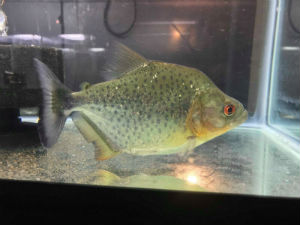
Black Piranhas
 The scientific name for black piranhas is Serrasalmus rhombeus. Black piranhas grow up to 43cm long in captivity, and have been known to live up to 28 years - a pet for life!
The scientific name for black piranhas is Serrasalmus rhombeus. Black piranhas grow up to 43cm long in captivity, and have been known to live up to 28 years - a pet for life!Black piranhas do not have the red-orange belly of red belly piranhas, but do have a distinctive red ring around their eyes also known as red eyed piranha. They are less aggressive than red belly piranhas, but are still predominantly carnivores. Some experts recommend keeping black piranhas as solitary fish in home aquariums, where other recommend keeping several specimens. Click here for a great guide for Black Piranha Care.
This species is quite difficult to breed in captivity. One problem is the size of the fish - such a large tank is needed to prevent other tank members, or indeed the parents, from eating the eggs that it is considered non-pragmatic. These fish can also be quite aggressive with each other - no lovey-dovey mother and father type activity with this piranha species. Black piranhas have been bred in captivity in the Duisberg Zoo Aquarium in Germany, and also in a zoo park in Florida. In both instances there was an enormous volume of water available for the fish.
The size record for a black piranha kept in captivity is just over 7 pounds - the fish are well over 16 inches at this weight.
Quick facts on Serrasalmus rhombeus:
Common Name: Black Piranha
Scientific Name: Serrasalmus rhombeus
Species: rhombeus
Origin: South America, particularly in the Amazon River basin
Size: Can exceed 18 inches in length
Care Level: Challenging, requires experienced care
Temperament: Aggressive
Diet: Carnivorous, feeds on fish, crustaceans, and aquatic prey
Minimum Tank Size: Large aquariums with ample swimming space
Temperature: Ideally between 75°F and 82°F
pH Range: 5.5 to 7.5

Looks like we are out of stock for Serrasalmus Rhombeus.
Click Here to See More Great Items on eBay!
FAQ's for Black Piranhas (Serrasalmus rhombeus)
What are the primary characteristics of Serrasalmus rhombeus?
Serrasalmus rhombeus, commonly known as the black piranha, is a large and robust fish characterized by its rhomboid-shaped body, powerful jaws, and distinctive dark coloration. Known for its predatory nature, this species is a formidable presence in aquatic ecosystems, especially in the Amazon Basin.
What is the typical size range of Serrasalmus rhombeus?
Adult black piranhas, Serrasalmus rhombeus, can reach an impressive size, often exceeding 18 inches (45 centimeters) in length. These fish undergo substantial growth, and their size can vary based on factors such as environmental conditions, diet, and age.
What is the natural habitat of Serrasalmus rhombeus?
Serrasalmus rhombeus is indigenous to the freshwater systems of South America, particularly in the Amazon River basin. These piranhas thrive in warm, slow-moving waters, including rivers, lakes, and flooded forests, where they play a crucial role in maintaining the ecological balance as apex predators.
What is the diet of Serrasalmus rhombeus?
The black piranha is a carnivorous species with a diet primarily consisting of fish, crustaceans, and other aquatic prey. They are known for their powerful bite and sharp teeth, which they use to tear through flesh. Additionally, they may consume smaller vertebrates and carrion.
How aggressive is Serrasalmus rhombeus?
Serrasalmus rhombeus is renowned for its aggressive behavior, especially during feeding. As apex predators, they exhibit territorial tendencies and can be highly defensive. Their aggression is heightened when protecting their nesting sites, and encounters with other piranhas or perceived threats can trigger intense confrontations.
Can Serrasalmus rhombeus be kept in aquariums?
While the black piranha is sometimes kept in large aquariums by experienced hobbyists, it requires careful consideration due to its size, aggression, and specific habitat needs. Adequate space, appropriate tank mates, and a well-balanced diet are essential for successfully keeping Serrasalmus rhombeus in captivity.
What are the distinctive features of Serrasalmus rhombeus compared to other piranha species?
Serrasalmus rhombeus stands out among piranhas with its rhomboid body shape and dark coloration. Compared to other species, it tends to have a more robust build and powerful jaws. These features contribute to its reputation as one of the largest and most formidable piranhas in its native habitats.
Are there any specific breeding behaviors associated with Serrasalmus rhombeus?
Breeding behavior in Serrasalmus rhombeus typically involves the establishment of nesting territories by dominant individuals. During the breeding season, heightened aggression is observed, and the fish engage in courtship rituals. Female black piranhas are known to deposit their eggs in submerged vegetation, and both parents may exhibit protective behaviors toward the eggs and fry.
What are the common challenges in maintaining Serrasalmus rhombeus in captivity?
Keeping Serrasalmus rhombeus in captivity poses challenges related to its size, aggression, and specific environmental requirements. Ensuring a large enough tank, providing suitable tank mates, and addressing their territorial nature are critical aspects. Additionally, meeting their dietary needs and maintaining water quality are ongoing considerations for successful captive care.
Is Serrasalmus rhombeus a species of conservation concern?
Currently, Serrasalmus rhombeus is not listed as a species of conservation concern. However, like many aquatic species in the Amazon Basin, its well-being is intricately tied to the health of its habitat. The impact of environmental changes, habitat destruction, and overfishing on the Amazon ecosystem may indirectly affect the population dynamics of Serrasalmus rhombeus.
